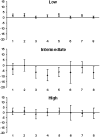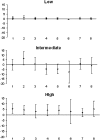Estimates of excess deaths associated with body mass index and other anthropometric variables
- PMID: 19190072
- PMCID: PMC2667465
- DOI: 10.3945/ajcn.2008.26698
Estimates of excess deaths associated with body mass index and other anthropometric variables
Abstract
Background: Estimates of excess mortality associated with body mass index (BMI; in kg/m(2)) have been calculated for the US population.
Objective: The objective of this article is to compare the excess mortality associated with BMI levels to the excess mortality associated with other anthropometric variables.
Design: For the 1988-1994 Third National Health and Nutrition Examination Survey, estimates of excess deaths were calculated for standard BMI levels and for comparable levels of percentage body fat, waist circumference, hip and arm circumferences, waist-hip ratio, the sum of 4 skinfold thicknesses, and waist-stature ratio. The outcome measure is the percentage of deaths in the full sample in excess of those predicted for the reference category.
Results: For the level equivalent to BMI <18.5, estimates of excess deaths ranged from 0.3% for waist-hip ratio to 2.4% for percentage body fat. All except waist circumference, waist-hip ratio, and waist-stature ratio were significantly greater than zero (P < 0.05). For the level equivalent to BMI 25 to <30, the percentage of excess deaths was 0.1% for percentage body fat and negative for all other variables; estimates were significantly below zero only for circumferences and waist-stature ratio. For the level equivalent to BMI > or = 30, estimates ranged from -1.7% for waist circumference to 1.5% for percentage of fat; none were significantly different from zero. Estimates for all-cause mortality, obesity-related causes of death, and other causes of death showed no statistically significant or systematic differences between BMI and other variables.
Conclusion: In this population-based study, attributable fractions of deaths were similar across measures.
Figures



Comment in
-
Waist versus weight: which matters more for mortality?Am J Clin Nutr. 2009 Apr;89(4):1003-4. doi: 10.3945/ajcn.2009.27598. Epub 2009 Feb 25. Am J Clin Nutr. 2009. PMID: 19244373 Free PMC article. No abstract available.
References
-
- Wellens RI, Roche AF, Khamis HJ, Jackson AS, Pollock ML, Siervogel RM. Relationships between the body mass index and body composition. Obes Res 1996;4:35–44 - PubMed
-
- Lemieux S, Prud'homme D, Bouchard C, Tremblay A, Despres JP. A single threshold value of waist girth identifies normal-weight and overweight subjects with excess visceral adipose tissue. Am J Clin Nutr 1996;64:685–93 - PubMed
-
- Roche AF, Sievogel RM, Chumlea WC, Webb P. Grading body fatness from limited anthropometric data. Am J Clin Nutr 1981;34:2831–8 - PubMed
-
- Roubenoff R. Applications of bioelectrical impedance analysis for body composition to epidemiologic studies. Am J Clin Nutr 1996(suppl);64:459S–62S - PubMed
-
- Lindqvist P, Andersson K, Sundh V, Lissner L, Bjorkelund C, Bengtsson C. Concurrent and separate effects of body mass index and waist-to-hip ratio on 24-year mortality in the Population Study of Women in Gothenburg: evidence of age-dependency. Eur J Epidemiol 2006;21:789–94 - PubMed
MeSH terms
LinkOut - more resources
Full Text Sources
Medical

